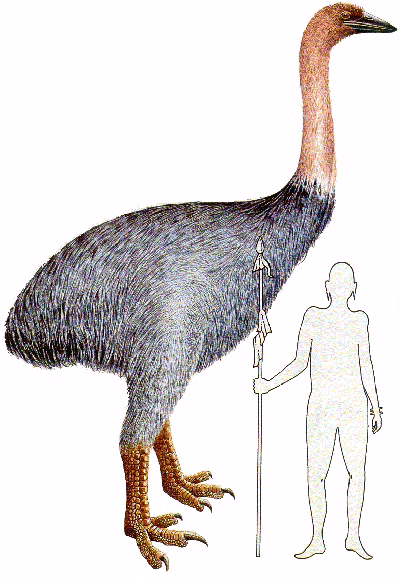Madagascar
The diversity and uniqueness of Madagascar's fauna makes this largest island in the Indian Ocean one of the most remarkable sanctuaries on Earth. Inhabited by humans during the first millennium of our era, its fauna had become greatly impoverished by the time the first
The extinction of a sizable proportion of the
 Birds
Birds
As on some other large islands as New Zealand, there was a rich fauna of giant flightless birds. There were seven species of these, and the largest, Aepyornis maximus, was over 10 feet (3 meters) tall. Along with the giant birds of New Zealand, these were the largest land birds ever
The western world's first tangible proof that these birds existed was the discovery of a giant egg in
Marco Polo and the Roc
Marco Polo, the famous Venetian traveller who crossed the Indian Ocean at the end of the 13th century, tells in his chapter on Madagascar and Zanzibar the story of a giant bird:
The people of the island report that at a certain season of the year, an extraordinary kind of bird, that they call a rukh [roc], makes its appearance from the southern region. In form it is said to resemble the eagle, but it is incomparably greater in size, being so large and strong as to seize an elephant with its talons, and to lift it into the air, whence it lets it fall to the ground, in order that when dead it may prey upon the carcass. Persons who have seen this bird assert that when the wings are
spread7 they measure sixteen paces in extent, from point to point, and that the feathers are eight paces in length, and thick in proportion.
Sinbad the Sailor is said to have seen an egg coming from a bird of incredible size.
These descriptions seem at first sight to correspond to Aepyornis, but the roc's powers of flight and the supposed presence of the elephants raise doubts. The roc may perhaps instead have been a giant bird of prey, also extinct, that lived alongside herds of dwarf elephants in the
Notes on this text
- It should go without saying that the Malayo-Polynesian people we now know as the Malagasy were the original voyagers, and they were followed by Arab traders well before the Europeans showed up. It is even possible that the Phoenicians set foot on Madagascar before the Malagasy, but if so they don't appear to have stayed long.
- "Malagasy" refers to the people and language of Madagascar; since the geography and biota of the island predate this introduction, "Madagascan" is arguably more correct in describing the avifauna. Anyway, what's the point of maintaining a webpage if I'm not allowed to quibble over such details?
- The prehistoric Mihirungs of Australia belong in this list, since one of them may well have been larger than the Vorompatra.
- Hunting probably played a part, but to give it primacy is somewhat controversial. It's easy to drive a large species to extinction without hunting them directly at all--eat enough of their eggs, or take away their environmental niche, and any bird species will disappear. Still, why wouldn't the Malagasy have hunted them, as the Maori hunted the Moa in New Zealand? As a general rule, a large species fields fewer individuals than a small species, so the loss of individuals in a population is more keenly felt. Given their restriction to this one island, even casual hunting and gradual encroachment by humans would have placed the Vorompatra in peril eventually.
- Technically, the eggs (for there were apparently three of them) were "discovered" in 1850 and may have reached Paris that same year, but the species does not appear to have been described and christened Aepyornis maximus until 1851.
- The presence of such cutting marks on the bones may be circumstantial. A recent article in the Independent suggests the Malagasy may even have had a taboo against eating these birds: then how would those marks be explained? It seems more likely to me that hungry islanders did eat some of them; it's also possible a taboo against eating them arose after the birds became scarce.
- Aepyornis maximus had vestigial wing bones, but no external wings; no further questions for this witness...
- Good point about elephants, there being none in Madagascar now (and no evidence that there ever were any). But, would the Malagasies have had a specific word for an animal that did not share their island? Isn't it possible that "elephant" was a mistaken translation for some other animal (e.g. the now-extinct dwarf hippopotamus of Madagascar) which the natives did know about? Sheer speculation, I know, but these are the dangers of taking tales literally--there are too many opportunities for error to creep into an account of a fantastic bird, even if we could trust that no one took it upon himself to make the story more interesting (à la "the Arabian Nights").


